There’s nothing like working in an office while pilings are being pounded into the ground next door, leading to crashing sounds of pile driving and the attendant afternoon headaches. Fortunately, that’s often the extent of a neighboring project’s real inconvenience. In other cases, however, construction in close quarters can mark the beginning of costly and emotional disputes, which can escalate to costly legal battles during and after construction.
Nuisance and Structural Damage Claims
Construction claims are often based on the concept of “nuisance,” or on structural damage to adjacent property. Nuisance claims are typically based on noise and dust from construction sites, while structural damage claims are based on direct physical damage caused by neighboring demolition, vibrations, excavation and dewatering. These types of claims can result in monetary damages for neighbor plaintiffs, loss of permits for contractors and reputational damage to the developer.
In one recent case in New York City, the developer faces up to $10 million in damages in a lawsuit with a neighboring property owner. The developer was conducting excavation, dewatering and installation of steel sheet piles, which the plaintiff alleges caused its five-story building to settle and shift, rendering doors inoperable and causing extensive cracking and separation of floors and ceilings from walls and supports. The plaintiff filed its complaint on Jan. 24, 2019, and the lawsuit is ongoing, exemplifying that construction claims such as these can be time consuming and costly (Complaint, 642 East 14th St. v. 644 E. 14th Realty [N.Y. Sup. Ct. January 24, 2019]).
Non-monetary costs associated with adjacent property damage claims can also be steep. In one infamous Philadelphia case, a construction crew destroyed a shared foundation wall while working underground, causing the ceiling of the neighboring rowhouse to cave in, and the stairs to separate from the wall. The city ordered demolition of the neighboring house, revoked the contractor’s permits and ordered a district attorney investigation of the incident.
Nuisance claims can be similarly costly. In a Texas nuisance case, plaintiff homeowners sued a developer constructing a project near their homes, alleging that vibrations, lights and noise caused “loss of use and enjoyment” of their properties. The court upheld an award of more than 0,000 to the neighbors even though the developer held proper city permits. The court specifically relied on the facts that the contractor worked “around the clock” for approximately four months, including weekends and holidays, using bright lights placed directly behind the plaintiffs’ homes to illuminate the worksite at night. Some of this around-the-clock work included excavation work performed within 20 feet of one of the plaintiff’s homes. The court held that these actions were “abnormal and out of place.” ( C.C. Carlton Indus. v. Blanchard, 311 S.W.3d 654 [Tex. App.—Austin, 2010, no pet.])
Risk-Mitigating Measures
High-risk projects in urban or high-density areas also put developers at risk of being sued by neighbors falsely claiming that preexisting damage was caused by the developer’s construction. Preconstruction surveys can save developers from opportunistic neighbors by debunking claims that they caused such damages.
One New York court reversed a previous injunction which prevented a developer from construction based on evidence shown in a preconstruction survey. In this case, the plaintiff alleged property damage resulting from excavation work. The court specifically relied on an independent engineering report showing that the damages alleged by the plaintiff were actually preexisting as shown by the preconstruction survey. (Feldman v. 3588 Nostrand Ave. LLC, 2020 NY Slip Op 31274 [U], ¶ 18 [Sup. Ct.])
Minimizing potential nuisance claims is a bit simpler. Developers can mitigate this risk by maintaining appropriate work hours and good worksite housekeeping practices. Also, developers should conduct a thorough review of the jurisdiction’s noise and vibration ordinances to ensure compliance. Proactive developers may consider visiting neighbors in advance to review the days and times when more obtrusive activities will take place.
Finally, while nuisance and structural damage claims can result in costly damage awards, the potential costs to goodwill between neighboring property owners should not be overlooked. Recognizing the disruption a project will cause and implementing disturbance mitigation measures can help owners and contractors avoid neighbor disputes.
This is the first article in a three-part series. Parts two and three will review preventative measures that can mitigate the relational fallout from construction incidents, and minimize the chances a construction project is tied up in costly and time consuming litigation.






